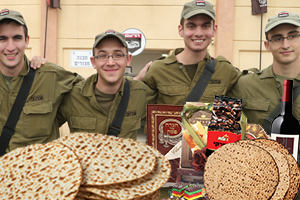Excavating 1400-year-old ruins next to the Temple Mount in Jerusalem, archaeologists from Hebrew University recently discovered two bundles containing 36 gold coins, gold and silver jewelry, and a 10-cm gold medallion with etchings of the menorah (Temple candelabrum), the shofar (ram’s horn), and a Torah scroll.
Dr. Eilat Mazar, a third generation archaeologist who led the dig, was astounded by the finds, telling The Philadelphia Trumpet that “it truly was amazing.” Dating to the late Byzantine period (early seventh century CE), the gold treasure was discovered in a ruined Byzantine public structure a mere 50 meters from the Temple Mount’s southern wall.
CLICK TO BUY THE MODERN DAY ‘JERUSALEM COIN’ DEPICTING THE GOLDEN MENORAH
The seven-branch golden menorah, as described in the Bible and used in the Holy Temple in Jerusalem, is part of the official symbol of the State of Israel. The menorah, depicted on the recently uncovered golden medallion, is clear evidence of Jewish presence in the area during that time. The medallion, along with a smaller gold medallion, two pendants, a gold coil and a silver clasp, were found in a depression in the floor of a stone building, and are all believed to be Torah scroll ornaments.
“Well, it’s obvious that it’s meant to hang on something. And I believe that there are only two options. It’s meant to hang on somebody, as a decoration, like a priest or somebody who is the head of the synagogue or the one praying with the Torah. It has to be connected to Judaism, of course, because of the seven-candled menorah. The other option was maybe it’s meant to decorate the Torah book. … When we found out that the other symbol [on the medallion] was a Torah book on the other side of the menorah, that option made more sense. It’s not usual, it’s not so common, to see such a symbol beside the menorah,” Mazar told The Trumpet.
CLICK TO BUY THE MODERN DAY ‘JERUSALEM COIN’ DEPICTING THE GOLDEN MENORAH
Given the date of the items and the manner in which they were found, Mazar estimates they were abandoned in the context of the Persian conquest of Jerusalem in 614 CE. After the Persians conquered Jerusalem, many Jews returned to the city and formed the majority of its population, hoping for political and religious freedom. But as Persian power waned, instead of forming an alliance with the Jews, the Persians sought the support of Christians and ultimately allowed them to expel the Jews from Jerusalem. The position of the items when they were discovered indicates that one bundle was carefully hidden underground while the second bundle was apparently abandoned in haste and scattered across the floor
Israel’s Prime Minister Benjamin Netanyahu said of the find “This is a magnificent discovery. Nationally, it attests to the ancient Jewish presence and to the sanctity of the place; this is as clear as the sun and it is tremendous.”
by Eitan Press, staff writer for United with Israel
Published: Sept 10, 2013
CLICK TO BUY THE MODERN DAY ‘JERUSALEM COIN’
To watch Hebrew University’s video about this priceless Jewish treasure, found right next to the Temple Mount in Jerusalem, please click below:
CLICK TO BUY THE MODERN DAY ‘JERUSALEM COIN’ DEPICTING THE GOLDEN MENORAH
Send Passover Packages to Needy Israeli Soldiers - Bring Them Joy!
We are honored to thank the young men and women of the IDF who risk their lives every day to protect the citizens of Israel. Since October 7th, soldiers have been on the battlefield for months - many are hoping to come home for Passover.
Join us in sending Passover food packages (and personal notes) to Israeli soldiers and their families.
Many soldiers spend the Passover holiday with needy families back home. The soldiers greatly appreciate your love and concern. Bring them Passover joy!
CLICK HERE TO SEND YOUR PACKAGE AND NOTE TO ISRAELI SOLDIERS!



